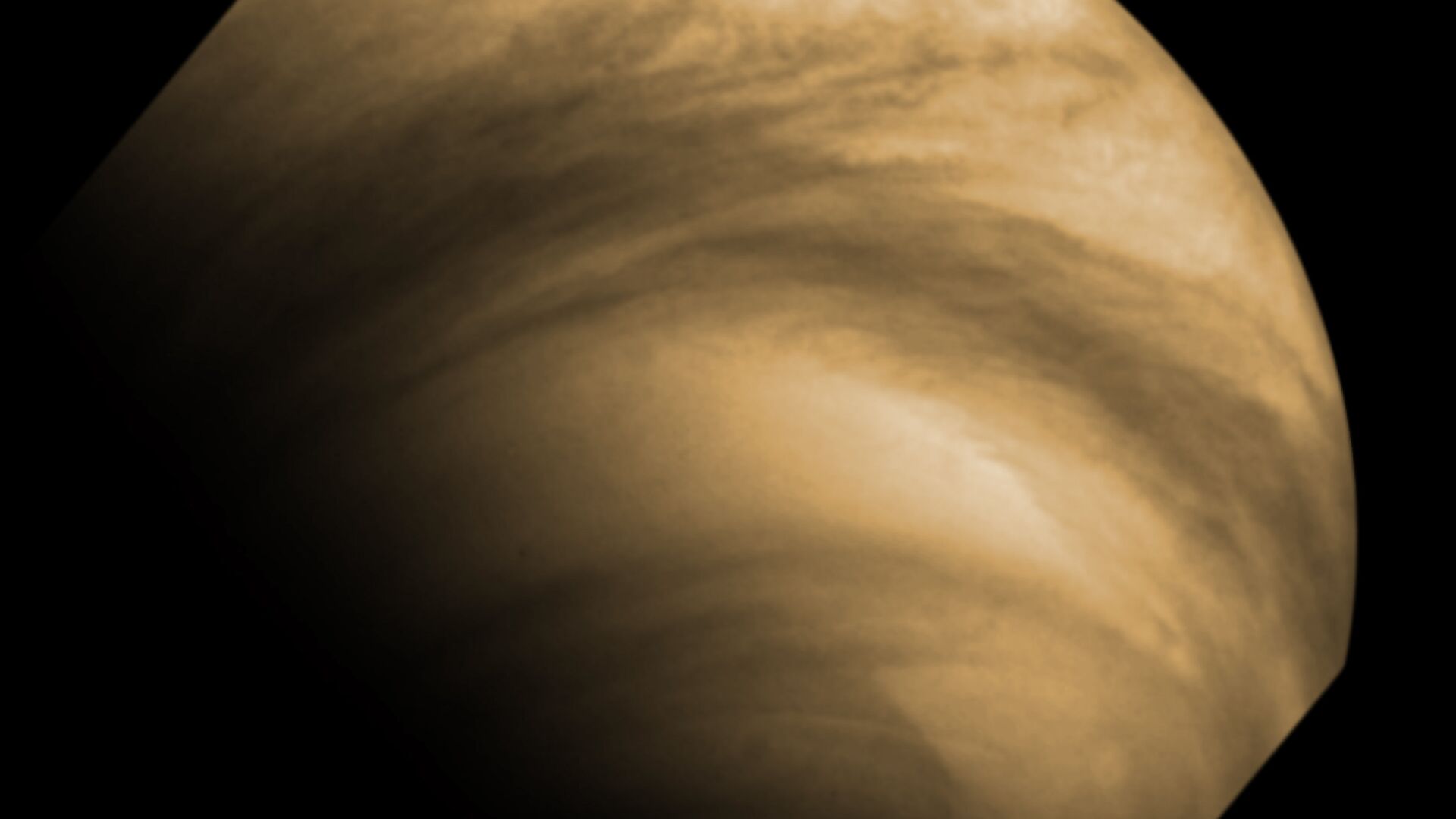https://sputnikglobe.com/20231108/astronomers-observe-atomic-oxygen-on-venus-harsh-day-side-for-first-time-1114827364.html
Astronomers Observe Atomic Oxygen on Venus’ Harsh Day Side for First Time
Astronomers Observe Atomic Oxygen on Venus’ Harsh Day Side for First Time
Sputnik International
A group of scientists studying the harsh and hostile atmosphere of Venus have, for the first time, detected atomic oxygen on the planet’s daytime side.
2023-11-08T21:29+0000
2023-11-08T21:29+0000
2023-11-08T21:28+0000
beyond politics
venus
oxygen
max planck institute
atmosphere
astronomy
https://cdn1.img.sputnikglobe.com/img/103852/62/1038526286_0:542:2388:1885_1920x0_80_0_0_20005b93304c0caacdf4c16051cb97bf.jpg
A group of scientists studying the harsh and hostile atmosphere of Venus have, for the first time, detected atomic oxygen on the planet’s daytime side.Because Venus has no magnetic field, solar wind from the sun penetrates deep into its cloudy atmosphere, where it breaks apart molecules into their constituent atoms, including the carbon dioxide that makes up 96% of the atmosphere. Highly ionized, those atoms are then carried by the planet’s swift wind currents to the dark side of the planet, where they recombine to form new molecules.On the night side, oxygen is easily observed in Venus’ atmosphere, but on the day side observation is much harder - so hard that a paper published in Nature Communications on Tuesday describes how a team of German scientists did it for the first time.The team found the atomic oxygen sandwiched between two layers of the Venus’ cloudy atmosphere at an altitude of about 60 miles from the surface. Below, hurricane-force winds whip around the planet in the same direction as it rotates, while above that layer, the winds blow in the opposite direction."On Earth, our life-protecting stratospheric ozone layer represents a well-known example of such photochemistry," Wiesemeyer added.Officials also found that the oxygen has a cooling effect on the atmosphere when it recombines with other elements, helping to bring down the temperature just a little bit.While at the surface, Venus is a sweltering 872 degrees Fahrenheit, the air pressure is equivalent to 3,000 feet under the ocean, and the air itself is composed of a caustic, poisonous mix of sulfuric acid and carbon dioxide higher up things begin to change. At the altitude the oxygen was discovered, scientists say the air pressure, temperature, and atmospheric composition are the closest to that seen on Earth of any non-Earth location in the solar system. With a floating base at that altitude, humans could establish a colony that might feel something like home.
https://sputnikglobe.com/20230412/launch-of-russian-first-space-mission-to-venus-postponed-till-2030s-1109383860.html
https://sputnikglobe.com/20220923/venus-movement-on-opposite-side-of-sun-caught-on-video-1101151627.html
venus
Sputnik International
feedback@sputniknews.com
+74956456601
MIA „Rossiya Segodnya“
2023
News
en_EN
Sputnik International
feedback@sputniknews.com
+74956456601
MIA „Rossiya Segodnya“
Sputnik International
feedback@sputniknews.com
+74956456601
MIA „Rossiya Segodnya“
venus; atmosphere; atomic oxygen; evil twin; planet; astronomy
venus; atmosphere; atomic oxygen; evil twin; planet; astronomy
Astronomers Observe Atomic Oxygen on Venus’ Harsh Day Side for First Time
Sometimes called “Earth’s twin” due to its nearly identical size and its location in the habitable zone of the sun’s orbit, Venus is a harsh world with a runaway greenhouse effect. It also spins extremely slowly, with a single day on Venus lasting 243 Earth days - even longer than a Venusian year.
A group of scientists studying the harsh and hostile atmosphere of Venus have, for the first time, detected atomic oxygen on the planet’s daytime side.
Because Venus
has no magnetic field, solar wind from the sun penetrates deep into its cloudy atmosphere, where it breaks apart molecules into their constituent atoms, including the carbon dioxide that makes up 96% of the atmosphere. Highly ionized, those atoms are then carried by the planet’s swift wind currents to the dark side of the planet, where they recombine to form new molecules.
On the night side, oxygen is easily observed in Venus’ atmosphere, but on the day side observation is much harder - so hard that
a paper published in Nature Communications on Tuesday describes how a team of German scientists did it for the first time.
To make their discovery, the scientists went through data gathered by the Stratospheric Observatory for Infrared Astronomy, (SOFIA), a NASA-German joint venture telescope mounted inside a special Boeing 747 jet, with a fine-toothed comb.
The team found the atomic oxygen sandwiched between two layers of the Venus’ cloudy atmosphere at an altitude of about 60 miles from the surface. Below, hurricane-force winds whip around the planet in the
same direction as it rotates, while above that layer, the winds blow in the opposite direction.
"This detection of atomic oxygen on Venus is direct proof for the action of photochemistry - triggered by solar UV radiation - and for the transport of its products by the winds of Venus' atmosphere," said astrophysicist and study co-author Helmut Wiesemeyer of the Max Planck Institute for Radio Astronomy in Germany.
"On Earth, our life-protecting stratospheric ozone layer represents a well-known example of such photochemistry," Wiesemeyer added.

23 September 2022, 18:52 GMT
Officials also found that the oxygen has a cooling effect on the atmosphere when it recombines with other elements, helping to bring down the temperature just a little bit.
While
at the surface, Venus is a sweltering 872 degrees Fahrenheit, the air pressure is equivalent to 3,000 feet under the ocean, and the air itself is composed of a caustic, poisonous mix of sulfuric acid and carbon dioxide higher up things begin to change. At the altitude the oxygen was discovered, scientists say the air pressure, temperature, and atmospheric composition are the closest to that seen on Earth of any non-Earth location in the solar system.
With a floating base at that altitude, humans could
establish a colony that might feel something like home.



